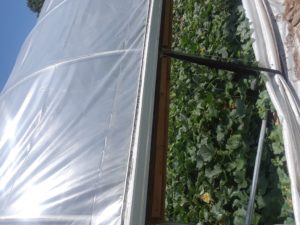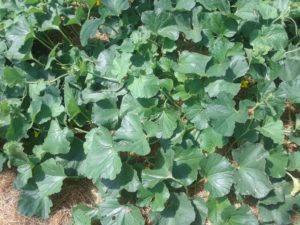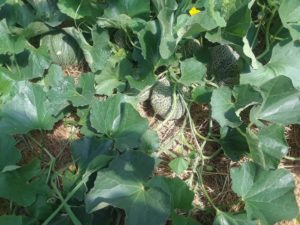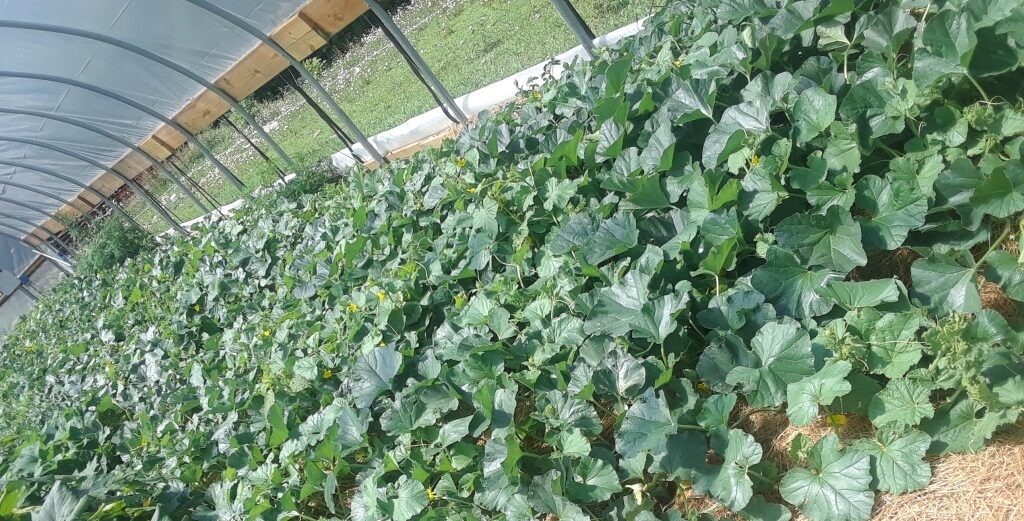–Karline Jensen, High Rocks, Hillsboro WV One of the first crops we decided to grow in our new high tunnel is melons. As you can see, they look great! We were able to plant them a month earlier than we would have dared to say we were past the chance of frost outside. In order to get the earliest melons possible, we had transplants started for us in a heated greenhouse three weeks before that.
We had added well-aged composted sheep manure for organic matter, and some rock phosphate fertilizer since our soil test said we were low in phosphorous. We tilled the soil into raised beds, laid out our drip tape, and mulched them heavily with old half-rotted hay for more organic matter. Once we transplanted the melons, they took off right away, and we didn’t even have to cover them with row covers, because as it turned out there weren’t any really cold nights the last month of spring this year. It is amazing how without any kind of a heater, the high tunnel is able to store the warmth of the day and keep it above freezing inside all night.

All of the plants in our high tunnel are thriving, and the leaves look perfect and unblemished because they are protected from the wind and driving rain that our outside crops have to deal with constantly. We have gutters on the high tunnel, that catch the rain and store it in underground cisterns. A submersible pump waters the crops with our drip irrigation system. This is another reason the leaves look so healthy– they always stay dry and are never splashed with soil by falling raindrops, so they have less chance of catching diseases.


We were worried that the pollinators might not find the melons, so we planted them along the outside wall, and we planted a little patch of mustard brassicas to attract the pollinators. And sure enough, once they started to bloom, we soon saw bees happily buzzing from one flower to the next! The pollination worked, because now there are melons growing. At first when you look at the patch, you see nothing but leaves. But move a few aside, and you will find plenty of melons!


This has been a great success for our first year with the high tunnel, but before we even harvest the melons we are looking forward to trying it again. We would like to try trellising and pruning the vines, because you definitely can’t walk on the path we left through the middle of the patch. We have been happy that we haven’t had problems with pests. Once while the plants were still mid-sized and you could still walk among them, we found some aphids. So we quickly ordered some insecticidal soap to spray them with, but somehow by the time it arrived all the aphids had died of some natural cause! We were not able to find any living.
The varieties we are growing are Jenny Lind Muskmelon and Blacktail Mountain Watermelon. We got the seeds from Fedco. We chose these because they had shorter days to maturity than some of the other varieties, and we wanted an early crop. The Jenny Lind has green flesh. Muskmelons are ripe when the fruit detaches from the vine with slight pressure. You don’t need to cut the stems. The Blacktail Mountain Watermelon is supposed to ripen at 71 days, and grows to 8-12 pounds. You can tell a watermelon is ripe by thumping it to see if it sounds hollow. They need to be cut, leaving about 1″ of stem.
Can’t wait to slice one up! Thanks to the advice from Lewis Jett that helped us to be so successful.





Leave A Comment